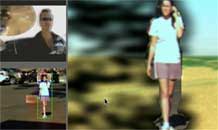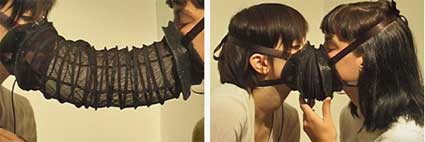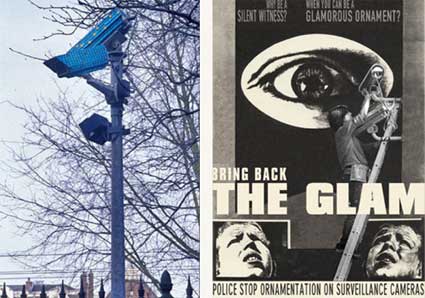Marisa Olson set up and moderated a fantastic panel yesterday afternoon at Conflux about Souveillance Culture. The panel was sponsored by Rhizome and gathered Amy Alexander, Jill Magid and Hasan Elahi, 3 artists whose work engages surveillance and explore the cultural and political implications of sousveillance. The panel assumed that we live in a surveilled society but also in a culture that likes to show and tell. Our society has shifted from one that cherished its right to privacy to a society that promotes the idea “if you see something, say something.”
Amy Alexander’s talk, Software, Surveillance, Scareness & Subjectivity was a presentation of SVEN: Surveillance Video Entertainment Network aka “AI to the People”, a software performance or installation for public spaces that she developed together with Wojciech Kosma, Vincent Rabaud with Nikhil Rasiwasia and Jesse Gilbert.
Video from the Whitney’s “Profiling” exhibition
Surveillance is scary and when you’re fearful you’re not very productive. You do not know when you are surveilled (that’s the principle of the Panopticon), nor do we know how (racial profiling, etc.)
 Much of the surveillance is based on softwares. Softwares should not be scary nor mysterious.
Much of the surveillance is based on softwares. Softwares should not be scary nor mysterious.
– 1987, William Bowles, The Dictatorship of the Machine, inspired by the arrival of the first Mcintosh computer,
– Hermetically Sealed Stuff is Magic. When something doesn’t work with Windows you naturally assumes that you must have done something wrong, not the technology. We often think of surveillance technology as a black box but it all comes down to some “human” intentions (algorithms) and mistake bugs: the software has its own ideas!
She showed as an example these images that document the results of an attempt to use computer vision algorithms to match photographs of individuals with those in a database. Most of the time, the algorithm detected the correct person from the database. However, the few incorrect cases are interesting. The software attempted to detect similarity between photographs and faces but instead of confusing people of the same race, for example, the software will sometimes confuse two people with a smug expression on their face (attitude profiling!) or wearing a bushy moustache.
Computer vision algorithms have their own agendas.
If a computer can decide when you are not “desirable”, it can also detect when you are desirable, that’s called Rock Star Detection which turns boring surveillance videos into exciting music videos. How does the system become suspicious that you might be a rock star?
– You are dressed for success (in black and with sun glasses: you might be Bono)
– You are blond (might be Kurt Cobain)
– you have a pout, etc.
When SVEN system detects any of these characteristics it generates an automatic music video surveillance cinematography.
Then Hasan Elahi got us riveted on our seat with the story of how he was arrested by the FBI and submitted to endless interviews and several polygraphs for, basically, having an Arab name (and thus flying with bombs in his pockets), it took him months to (he thought) convince them that he was innocent. Suspecting that he might never be totally cleared he devised a software that tracks him wherever he goes. If you visit the website Tracking Transience, you’ll see where he is now, where he was a a few days ago, which airport he went through, what he ate on the plane, how much money he spent where, etc.
![]()
Interestingly, when he has a look at who is visiting the website, he discovered that the users who logs in come from the Department of Homeland Security, the Department of Justice (the FBI), the House of Representents, etc. During the discussion that floowed the talks, Elahi explained how his project devalue the FBI file by flooding them with data. And although the work makes his life transparent, he hasn’t lost any parcel of intimacy. You never see his face or body on the pictures and while you can see what he had at lunch in a plane that doesn’t tell you much about himself.
Jill Magid gave an overview of her surveillance-inspired works.
The idea to engage with surveillance technology came while she was still a student working on the Kissmask piece. At the time she was also looking for a way to connect the two “kissers” together, maybe with video. So she asked around how she could do that and was advised to use a lipstick spy camera.

She later used the camera to perform Lobby 7 in MIT main lobby. She phoned the manufacturer of the lobby’s informational monitor pretending she had lost the remote control, was sent one and hijacked the monitor, interrupting its daily broadcast with a transmission of her own. This transmission was a real-time exploration of her body and the surrounding architecture as seen through the openings of her clothes, via the lipstick surveillance camera. A camera was recording the 30 min performance and the reaction of passersby. Many of them reached out and patted their body, suspecting that it might be them on the screen.

She explained that she liked the aesthetics of the surveillance camera images, how any given space looks like a stage on a screen and anyone who enters it becomes an actor.
Later on she spent 5 years in Amsterdam where the word “repression” doesn’t have the same importance as in Boston. She nevertheless noticed the presence of surveillance cameras in the city. There are there as icons of power, sometimes mere decoy that does not necessarily work. She hand-glued rhinestones to security cameras in front of the Rijksakademie and people suddenly noticed the cams, asking them when and why she had installed the camera although they had been there for 7 years.

Next she set herself the task to do the same at the Amsterdam Headquarters of Police. When she phoned to ask whether that would be possible she was told that “we don’t work with artists.” She thus had to create her own company System Azure Security Ornamentation, took a formal appointment with the police and arrived with her portfolio of glam cams under the arm.
The artist was not only authorised to glue rhinestone on the police CCTV cameras using permanent adhesive but she was also hired and paid to do so.
It was decided that the colours used would make the 9 cameras in front of the HQ look like flags. She used colours from the international code: Green is for justice, white for integrity, red is for full of love, etc.
Because of a lack of time, Jill Magid had to skip Evidence Locker and go straight to the project Lincoln Ocean Victor Eddy (L.O.V.E.)
Back to New York City after five years abroad, she kept hearing this announcement in the subway “You may be a subject to searches “for security reasons”.” She approached a police officer and asked him to search her. He refused because only women officer had the right to search a woman but she managed to convince him to call her and tell her each night where he was on shift and she’d join him to be “trained”. She kept record of the meetings and logged them in different forms. More about the project.
